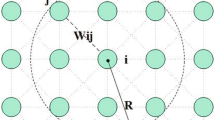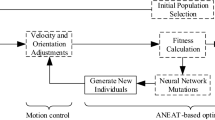Abstract
Robot technology includes many fields such as machinery manufacturing, sensor application and recognition, electronic technology, automation, and artificial intelligence. In recent years, with the development of automation technology and artificial intelligence, robotic technology has evolved significantly. According to various applications, robots are divided into industrial robots, agricultural robots, home robots, and medical robots. With the continuous development and diffusion of robotic technology, there is a growing demand for innovative robotic road design. Compared with multi-object road design, multi-object road design can have an overview of various factors such as distance, safety, and quietness. This is why the design of multi-lane roads is more in line with the current situation. The traditional local path planning method has some shortcomings, such as local optimum, poor real-time performance, and high requirements for the moving speed of obstacles. This paper proposes corresponding solutions for the problems that cannot be solved well in common path planning algorithms. For algorithm-based research on local path planning method, the paper introduces the establishment of local path planning environment model and puts forward the basic framework of path planning. By optimizing the genetic algorithm, this paper obtains the optimal topology and optimal weight of the network and combines the genetic algorithm with the long short-term memory neural network. The experimental results show that the time required for multi-objective path planning by the method in this paper is 12.5 s, 11.7 s, 12.2 s and 14.9 s, respectively. Compared with the existing methods, the time required is significantly reduced, and the method in this paper improves the efficiency of path planning.










Similar content being viewed by others
Availability of data and materials
This article does not cover data research. No data were used to support this study.
Code availability
This article does not cover code research.
References
Zhou X, Zhan Y, Feng G et al (2019) Individualized tour route plan algorithm based on tourist sight spatial interest field. ISPRS Int J Geo Inf 8(4):192
Naus K (2019) Drafting route plan templates for ships on the basis of AIS historical data. J Navig 73(3):1–20
Hun-Gyu H (2017) Bae-Sung, An evaluation of effectiveness for providing safety navigation supporting service: focused on route plan sharing service. J Korea Inst Inf Commun Eng 21(3):620–628
Chen EY (2017) A neural network model of cortical information processing in schizophrenia II - role of hippocampal-cortical interaction: a review and a model. Can J Psychiatry 40(1):21–26
Ongpeng J, Soberano M, Oreta A (2017) Artificial neural network model using ultrasonic test results to predict compressive stress in concrete. Comput Concr 19(1):59–68
Liao Y, Kodagoda S, Yue W (2017) Place classification with a graph regularized deep neural network model. IEEE Trans Cognit Dev Syst 9(4):304–315
Kang IS, Yang YK, Lee HE (2017) Development of an artificial neural network model for a predictive control of cooling systems. Int J Korea Inst Ecol Archit Environ 17(5):69–76
Al-Zwainy F, Abd-Allah AI (2017) Forecasting the cost of structure of infrastructure projects utilizing artificial neural network model (highway projects as case study). Indian J Sci Technol 10(20):1–12
Liao Y, Kodagoda S, Yue W (2017) Place classification with a graph regularized deep neural network model. IEEE Trans Cognit Dev Syst 9(4):304–315
Mall S, Chakraverty S (2017) Single layer Chebyshev neural network model for solving elliptic partial differential equations. Neural Process Lett 45(3):1–16
Pedersen TS, Nielsen KM, Hindsborg J (2017) Predictive functional control of superheat in a refrigeration system using a neural network model. IFAC-PapersOnLine 50(1):43–48
Ayodele BV, Mustapa SI, Witoon T (2021) Radial basis function neural network model prediction of thermo-catalytic carbon dioxide oxidative coupling of methane to C2-hydrocarbon. Top Catal 64(5):328–337
Ding M (2018) A neural network model for predicting weighted mean temperature. J Geodesy 92(10):1–12
Saha AK, Choudhury S, Majumder M (2017) Performance efficiency analysis of water treatment plants by using MCDM and neural network model. MATTER Int J Sci Technol 3(1):27–35
Sun Q, Wu C, Li YL (2017) A new probabilistic neural network model based on backpropagation algorithm. J Intell Fuzzy Syst 32(1):215–227
Bhattacharyay D (2017) D Ko caef e, Ko Caef E Y, An artificial neural network model for predicting the CO2 reactivity of carbon anodes used in the primary aluminum production. Neural Comput Appl 28(3):553–563
Zhang N, Ma Y, Zhang Q (2017) Prediction of sea ice evolution in Liaodong Bay based on a back-propagation neural network model. Cold Reg Sci Technol 145(Jan.):65–75
Kumar M, Thenmozhi M (2017) A hybrid ARIMA-EGARCH and artificial neural network model in stock market forecasting: evidence for India and the USA. Int J Bus Emerg Mark 4(2):160–178
Alam AG, Rahman H, Kim JK (2017) Uncertainties in neural network model based on carbon dioxide concentration for occupancy estimation. J Mech Sci Technol 31(5):2573–2580
Ji K, Ling M, Zhang Y et al (2017) An artificial neural network model of LRU-cache misses on out-of-order embedded processors. Microprocess Microsyst 50(May):66–79
Sahu SK, Anand A (2018) What matters in a transferable neural network model for relation classification in the biomedical domain? Artif Intell Med 87(May):60–66
Wu H, Zhao J (2018) Deep convolutional neural network model based chemical process fault diagnosis. Comput Chemical Eng 115(Jul.12):185–197
Kim M, Kim H (2017) Integrated neural network model for identifying speech acts, predicators, and sentiments of dialogue utterances. Pattern Recognit Lett 101(Jan. 1):1–5
Author information
Authors and Affiliations
Contributions
All authors contribute equally.
Corresponding author
Ethics declarations
Ethics approval
Not applicable. The article does not cover human or animal research.
Consent to participate
All authors have seen the manuscript and approved to submit to your journal.
Consent for publication
All authors have seen the manuscript and approved to submit to your journal.
Conflict of interest
The authors declare no competing interests.
Additional information
Publisher's note
Springer Nature remains neutral with regard to jurisdictional claims in published maps and institutional affiliations.
Rights and permissions
Springer Nature or its licensor holds exclusive rights to this article under a publishing agreement with the author(s) or other rightsholder(s); author self-archiving of the accepted manuscript version of this article is solely governed by the terms of such publishing agreement and applicable law.
About this article
Cite this article
Su, J., Jiang, C. & Li, Y. Multi-source and multi-objective path planning based on genetic optimized long short-term memory neural network model. Int J Adv Manuf Technol (2022). https://doi.org/10.1007/s00170-022-10046-0
Received:
Accepted:
Published:
DOI: https://doi.org/10.1007/s00170-022-10046-0




